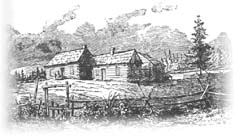
George JAMIESON was born Oct 26 1826 in Stonehouse Lanark,
the youngest child of James JAMIESON & Isabell GRAY
who had married Jul 4 1804 in Stonehouse Lanark Scotland.
George Jamieson & Ellen Speed

George JAMIESON was born Oct 26 1826 in Stonehouse Lanark,
the youngest child of James JAMIESON & Isabell GRAY
who had married Jul 4 1804 in Stonehouse Lanark Scotland.
|
|
George emigrated to Australia in Oct 1852
aboard the ship 'Lord Warriston' (Port B / Fiche 11 / Page 2).
His nieces, Ann and Marion GOVAN also emigrated to Australia in 1852
aboard the ship 'Boomerang'.
|
|
|
Ellen SPEED was the daughter of William SPEED Jr by his 1st marriage to Mary PLUNKETT.
Willam's 2nd marriage was Dec 1853 to Marion Waugh JAMIESON, George's niece !!
 |
From the Book: "Echuca ~ A Centenary History" by Susan Priestly (1965)"
Entitled: "JAMIESON'S POUND"
|
On 23 July 1854, JAMIESON, as poundkeeper, Tke sustenance rates ranged from fourpence a day for sheep; JAMIESON kept his pound in first-class order, In 1857 Hopwood considered him such an excellent man of business Indeed, during it's first four years or so, |
~ George JAMIESON was my GR GR uncle ~

Return to JAMIESON Direct Ancestor Line